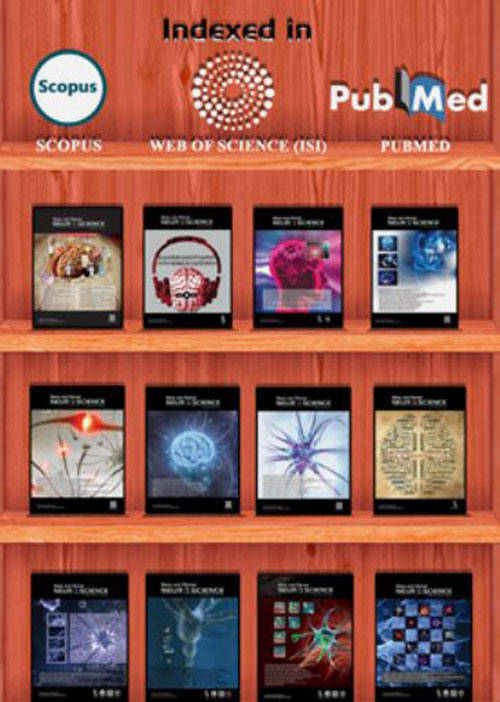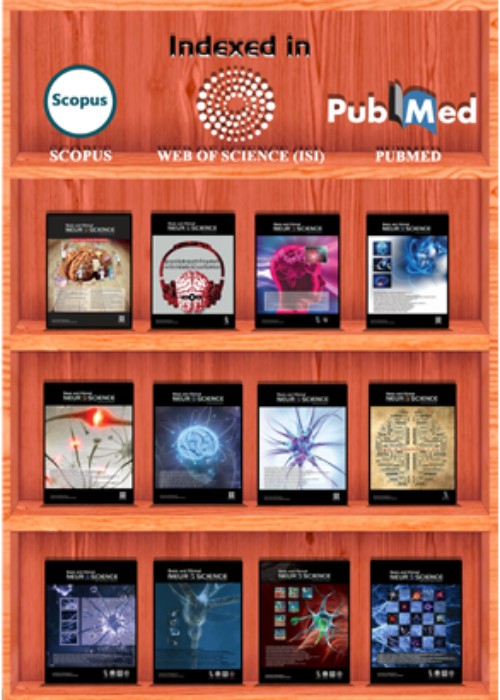فهرست مطالب

Basic and Clinical Neuroscience
Volume:10 Issue: 1, Jan-Feb 2019
- تاریخ انتشار: 1397/11/23
- تعداد عناوین: 8
-
-
Pages 1-11Neuromodulators modify intrinsic characteristics of the nervous system in order to reconfigure the functional properties of neural circuits. This reconfiguration is crucial for the flexibility of the nervous system to respond on an input-modulated basis. Such a functional rearrangement is realized by modification of intrinsic properties of the neural circuits including synaptic interactions. Dopamine is an important neuromodulator involved in motivation and stimulus-reward learning process, and adjusts synaptic dynamics in multiple time scales through different pathways. The modification of synaptic plasticity by dopamine underlies the change in synaptic transmission and integration mechanisms, which affects intrinsic properties of the neural system including membrane excitability, probability of neurotransmitters release, receptors’ response to neurotransmitters, protein trafficking, and gene transcription. Dopamine also plays a central role in behavioral control, whereas its malfunction can cause cognitive disorders. Impaired dopamine signaling is implicated in several neuropsychiatric disorders such as Parkinson’s disease, drug addiction, schizophrenia, attention-deficit/hyperactivity disorder, obsessive-compulsive disorder and Tourette’s syndrome. Therefore, dopamine plays a crucial role in the nervous system, where its proper modulation of neural circuits may enhance plasticity-related procedures, but disturbances in dopamine signaling might be involved in numerous neuropsychiatric disorders. In recent years, several computational models are proposed to formulate the involvement of dopamine in synaptic plasticity or neuropsychiatric disorders and address their connection based on the experimental findings.Keywords: Dopamine, Neuromodulation, Neuropsychiatric disorders, Synaptic plasticity
-
Pages 13-22IntroductionThe current study aimed at investigating the role of Nitric Oxide (NO) in the maintenance of anxiety and depression induced by stress in male Wistar rats using intra-Basolateral Amygdala (BLA) injection of NO precursor, L-arginine, Nitric Oxide Synthase (NOS) inhibitor, and L-NAME.MethodsTwo 23-gauge stainless steel cannulas were placed in the BLA, stereotaxically. Seven days later, animals experienced electro foot shock stress based on the following protocol: animals experienced four sessions of stress for 60 minutes in four consecutive days. Five minutes before each stress session, the animals received different doses of L-arginine or L-NAME (1, 5 and, 10 μg/rat) or saline (0.5 μL/rat) intra-BLA. Six days after the stress termination, animals were tested for maintenance of anxiety-like behavior (elevated plus maze; EPM) and eight days after the stress they were examined for depression (forced swimming test; FST).ResultsStress reduced the time and number of open arms and decreased motor activity on EPM. Stress-induced anxiety was inhibited by L-arginine and L-NAME (1, 5, and 10 µg/rat). L-Arginine and L-NAME induced anxiety in non-stressed rats. Stress also increased the immobility time in animals in FST paradigm. Interestingly, both L-arginine and L-NAME, in all doses reduced the stress effect.ConclusionBLA nitric oxide may play a pivotal role in anxiety and depression induced by stress in rats. Since the effects of both L-arginine and L-NAME were similar, NO might have a modulatory role in the BLA.Keywords: Anxiety, Basolateral Amygdala, Depression, Nitric Oxide, L-Arginine, Stress
-
Pages 23-36IntroductionIt is well documented that insulin has neuroprotective and neuromodulator effects and can protect against different models of memory loss. Furthermore, cholinergic activity plays a significant role in memory, and scopolamine-induced memory loss is widely used as an experimental model of dementia. The current study aimed at investigating the possible effects of insulin against scopolamine-induced memory impairment in Wistar rat and its underlying molecular mechanisms.MethodsAccordingly, animals were bilaterally cannulated in CA1, hippocampus. Intrahippocampal administration of insulin 6 MU and 12 MU in CA1 per day was performed during first 6 days after surgery. During next four days, the animal’s spatial learning and memory were assessed in Morris water maze test (three days of learning and one day of retention test). The animals received scopolamine (1 mg/kg) Intraperitoneally (IP) 30 minutes before the onset of behavioral tests in each day. In the last day, the hippocampi were dissected and the levels of MAPK (mitogen-activated protein kinases) and caspase-3 activation were analyzed by Western blot technique.ResultsThe behavioral results showed that scopolamine impaired spatial learning and memory without activating casapase-3, P38, and JNK, but chronic pretreatment by both doses of insulin was unable to restore this spatial memory impairment. In addition, scopolamine significantly reduced Extracellular signal-Regulated Kinases (ERKs) activity and insulin was unable to restore this reduction. Results revealed that scopolamine-mediated memory loss was not associated with hippocampal damage.ConclusionInsulin as a neuroprotective agent cannot restore memory when there is no hippocampal damage. In addition, the neuromodulator effect of insulin is not potent enough to overwhelm scopolamine-mediated disruptions of synaptic neurotransmission.Keywords: Alzheimer Disease, Cholinergic neurons, Scopolamine, Mitogen-Activated Protein Kinases, Caspase-3, Apoptosis
-
Pages 37-47IntroductionConverging evidence suggests that both emotional and cognitive processes are critically involved in moral judgment, and may be mediated by discrete parts of the prefrontal cortex. The current study aimed at investigating the mediatory effect of right Frontopolar Cortex (rFPC) on the way that emotions affect moral judgments.MethodsSix adult patients affected by rFPC and 10 healthy controls were included in the study. Participants made judgements on moral dilemmas after being shown either neutral or emotional pictures. The role of rFPC in executive control and emotional experience was also examined.ResultsThe study results showed that inducing an emotional state increased the number of utilitarian responses both in the patients and controls. However, no significant differences were observed between the patients and controls in response time or the number of utilitarian responses. Also, no significant differences were observed in personal and impersonal dilemmas before and after the emotion induction in intergroup comparisons. Results of the executive control tasks showed reduced performance in patients affected by rFPC compared with the controls.ConclusionThe results of the current study suggested that rFPC might not have a direct role in mediating emotional processes during moral judgments, but possibly this region is important in a network supporting executive control functions.Keywords: Emotion induction, Frontopolar cortex, Personal, impersonal Moral judgement, Executive control, Wisconsin Card Sorting Test
-
Pages 49-57IntroductionIt is a long time that natural toxin research is conducted to unlock the medical potential of toxins. Although venoms-toxins cause pathophysiological conditions, they may be effective to treat several diseases. Since toxins including scorpion toxins target voltage-gated ion channels, they may have profound effects on excitable cells. Therefore, elucidating the cellular and electrophysiological impacts of toxins, particularly scorpion toxins would be helpful in future drug development opportunities.MethodsIntracellular recording was made from F1 cells of Helix aspersa in the presence of calcium Ringer solution in which Na+ and K+ channels were blocked. Then, the modulation of channel function in the presence of extracellular application of F4 and F6 toxins and kaliotoxin (KTX; 50 nM and 1 μM) was examined by assessing the electrophysiological characteristics of calcium spikes.ResultsThe two active toxin fractions, similar to KTX, a known Ca2+-activated K+ channel blocker, reduced the amplitude of AHP, enhanced the firing frequency of calcium spikes and broadened the duration of Ca2+ spikes. Therefore, it might be inferred that these two new fractions induce neuronal hyperexcitability possibly, in part, by blocking calcium-activated potassium channel current. However, this supposition requires further investigation using voltage clamping technique.ConclusionThese toxin fractions may act as blocker of calcium-activated potassium channels.Keywords: Scorpion Venom, Intracellular recording, Calcium spike, Buthotus schach
-
Pages 59-71IntroductionBased on the literature, unihemispheric concurrent dual-site anodal transcranial Direct Current Stimulation (a-tDCSUHCDS) of primary Motor cortex (M1) and Dorsolateral Prefrontal Cortex (DLPFC) would be more efficient than conventional a-tDCS of M1 to induce larger and longer-lasting M1 corticospinal excitability. The main objective of the present study was to compare the effects of a-tDCSUHCDS and conventional M1 a-tDCS on the extent and durability of the motor sequence acquisition in healthy individuals.MethodsIn this randomized sham-controlled study, healthy volunteers were randomly divided into three groups: experimental (a-tDCSUHCDS), control (M1 a-tDCS), and sham stimulation groups. The participants practiced serial response time task over three consecutive days when they simultaneously received a-tDCS. Using the skill measure, we assessed motor learning up to 4 weeks after the completion of experimental conditions.ResultsData analysis revealed that all groups exhibited the improved trend over the training course (P0.05).ConclusionThese results revealed a significant increase in the skill acquisition by a-tDCSUHCDS technique with regard to retention issue, which could be a valuable finding in neuro-rehabilitation field.Keywords: Transcranial direct current stimulation, Primary motor cortex, Dorsolateral prefrontal cortex, Learning, Motor skills
-
Pages 73-84IntroductionBased on our previous findings, the treatment of stem cells alone or in combination with thyroid hormone (T3) and mild exercise could effectively reduce the risk of stroke damage in young mice. However, it is unclear whether this treatment is effective in aged or middle-aged mice. Therefore, this study designed to assess whether combination of Bone Marrow Stromal Cells (BMSCs) with T3 and mild treadmill exercise can decrease stroke complications in middle-aged mice.MethodsUnder laser Doppler flowmetry monitoring, transient focal cerebral ischemia was produced by right Middle Cerebral Artery Occlusion (MCAO) for 45 min followed by 7 days of reperfusion in middle-aged mice. BMSCs (1×105) were injected into the right cerebral ventricle 24 h after MCAO, followed by daily injection of triiodothyronine (T3) (20 µg/100 g/d SC) and 6 days of running on a treadmill. Infarct size, neurological function, apoptotic cells and expression levels of Glial Fibrillary Acidic Protein (GFAP) were evaluated 1 week after stroke.ResultsPost-ischemic treatment with BMSCs or with T3 and or mild treadmill exercise alone or in combination did not significantly change neurological function, infarct size, and apoptotic cells 7 days after ischemia in middle-aged mice (P>0.05). However, the expression of GFAP significantly reduced after treatment with BMSCs and or T3 (P<0.01).ConclusionOur findings indicate that post-stroke treatment BMSCs with exercise and thyroid hormone cannot reverse neuronal damage 7 days after ischemia in middle-aged mice. These findings further support that age is an important variable in stroke treatmentKeywords: Cerebral ischemia, Combination, Bone marrow stromal cells, Thyroid hormone, Exercise, Apoptosis, Glial fibrillary acidic protein, Middle-aged, Mice
-
Pages 85-97IntroductionFinding herbs with promising effects to prevent or postpone Alzheimer Disease (AD) is highly demanded. The present study aimed at clarifying plausible effects and related mechanism(s) of Zataria Multiflora Essential Oil (ZMEO) against memory impairment in a rat model of the AD.MethodsForty male adult rats were categorized into four groups and treated as follows: 1. The Negative Control (NC): no treatment; 2. Sham control (sham): distilled water by Intracerebroventricular (ICV) injection; 3. The AD control (AD): Aβ 1-42 by ICV injection; and 4. The ZMEO group: Aβ 1-42 by ICV injection and ZMEO at 100 μL/kg/d orally for 20 days.ResultsAfter Congo red staining of the hippocampus, a relative decrease in amyloid deposits was observed in the ZMEO group. Moreover, rats showed better outcomes in Morris Water Maze (MWM) test, reduced hippocampal acetylcholinesterase (AchE) activity, and higher Brain-Derived Neurotrophic Factor (BDNF) content as compared with the AD group (P0.05).ConclusionZMEO has a protective effect against memory impairment in rats with AD at least partly via reducing hippocampal AchE activity and enhancement of BDNF levels without a change in antioxidant status. These findings can pave the way for future studies on the usefulness of this herb in AD prevention.Keywords: Alzheimer Disease, Acetylcholinesterase, Brain-derived neurotrophic factor, Antioxidants


